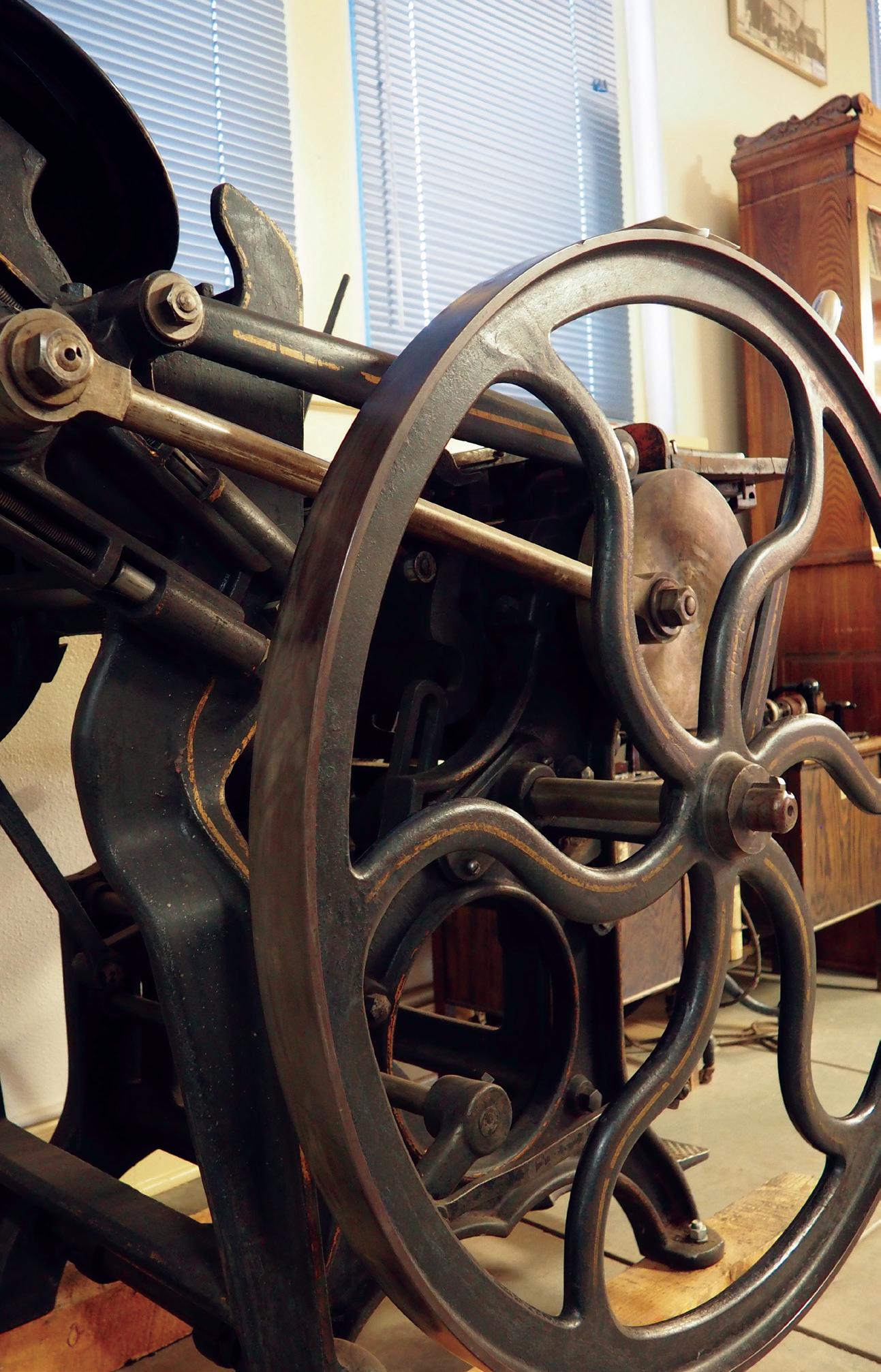
4 minute read
An Adventure Through History
Getting to Know the Museums at ENMU
Roosevelt County Historical Museum

Founded in 1940, the Roosevelt County Historical Museum is located on the north end of campus across from the Administration Building. All items and displays have been donated by Roosevelt County residents, and upon entering the museum, visitors are immediately swept backward in time to the early life and times of the county’s residents. The displays reflect the 12,000-year history using antique furniture and an Edison phonograph, as well as the technology of the past as evidenced by the printing press pictured to the left, patented in 1899, and a medical instrument collection. There is clothing and equipment from local ranches including a peanut roaster from the 1890s, examples of old typewriters, cash registers and sewing machines, and a dentist’s office. The museum also owns one of the few examples of a 47-star United States flag.
Gennaro Natural History Museum
This live-animal exhibit was originally developed by Dr. Anthony ‘Tony’ Gennaro and was housed in the basement of Roosevelt Science Center. It’s popularity with students and the public grew rapidly and it moved to the first floor, where there was more room and easier access. Today the museum houses both live animals and preserved specimen exhibits. The emphasis is on the fauna found in the eastern New Mexico to west Texas region, allowing visitors to see some of the wildlife that calls this area home.

The live exhibits provide an easy-access, safe environment for both the public and the creatures on display including reptiles, fish and invertebrates like the American alligator, rattle snakes and the gar.
This museum is a great resource for the Department of Biology, the University and the residents of the area. It is regularly used as a teaching resource for biology classes, and students work with faculty and staff to maintain the museum and its exhibits. Local school groups (mainly grades K-4) also visit to enhance their early learning experiences in the life sciences. Each year the museum receives over 4,000 visitors. This museum is a real gem and we look forward to continued success and engagement in the years to come.
Miles Mineral Museum
Submitted by Dr. Jim Constantopoulos, Professor of Geology, Director and Curator

When Fred Miles and his wife Gladys moved to Roswell, New Mexico in 1928, they began exploring along the Pecos River. There they found beautiful quartz crystals called Pecos Valley Diamonds. This was the beginning of a love affair with minerals and rocks which lasted for 40 years and was the beginning of the Miles Collection. The collection was displayed in a back room at his Texaco service station in Roswell. If you mentioned any interest in minerals and rocks, he would proudly show off his collection, which also included Native American artifacts.
In August of 1966, Miles and ENMU entered into an agreement to purchase the collection, which included approximately 2500 geological, archaeological and anthropological specimens. On Feb. 23, 1969 the Miles Museum was opened on the ENMU campus. The museum was originally housed in space adjacent to Lee Hall. After several moves around campus, in 1997 the collection was placed on display in the present space on the first floor of Roosevelt Science Center. Most of the specimens on display are from the original Miles Collection. Additional specimens have been obtained through donations and purchases.
Blackwater Draw National Historic Landmark and Museum
Visitors have the opportunity to learn about the earliest Paleoindian cultures in North America while touring this interactive archaeology site located six miles north of Portales. The Blackwater Draw National Historic Landmark is a 640-acre landscape of human activity areas in an upland area that once contained a major water source: the spring-fed Pleistocene lake. View uncovered bison bones in the Interpretive Center, well as many species of extinct fauna and various projectile points and tools in the Visitor Center. Outstanding bone preservation allows visitors to view different areas of a bison kill site as they were laid down thousands of years ago.

The original Blackwater Draw Museum was built in 1969 to house the artifacts excavated from Blackwater Draw. This past May, the museum opened the doors to a new home on ENMU’s campus in Lea Hall, focusing on the 85 years of work at Blackwater Draw, as well as the broader material cultures of the Southern High Plains. The museum also houses the Miles Anthropological Collection and the Calvin Smith Collections, as well as several other donated collections.

The new location for the Blackwater Draw Museum opened with a ribbon-cutting ceremony in May of 2017. From L-R: Roosevelt County Chamber of Commerce representatives Victoria Garrett (MA 82, BUS 77) and Karl Terry, John Montgomery, Cori Snobble, museum curator Jenna Domeischel, former museum director George Crawford (BS 88), former ENMU President Dr. Steven Gamble, Chamber of Commerce representative Kathy Mead and ENMU Foundation Executive Director Noelle Bartl (BS 92).










